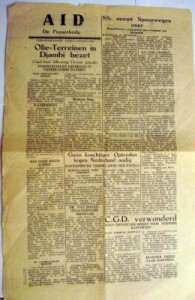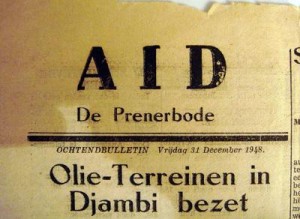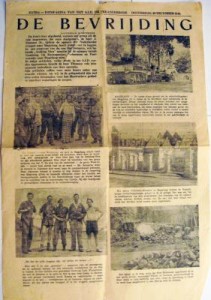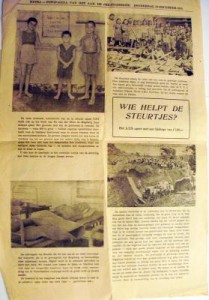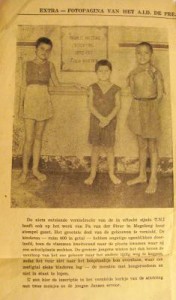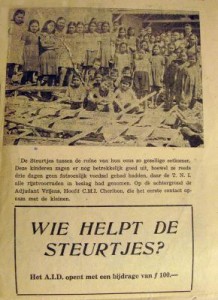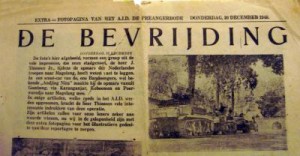Life in Java, internment in war, and evacuation to Singapore and Australia 1900–1953
- Section 1: Life in Java in the early 20th century
- Section 2: The clouds of war, 1939–1942
- Section 3: Internment in Java: Kwarassan, Banjoe Biroe X and Banjoe Biroe XI
- Section 4: Japanese capitulation and the Indonesian Revolution
- Section 5: Battle of Surabaya
- Section 6: Evacuation to Singapore, November 1945
- Section 7: Evacuation to Australia, 1945–1946
- Section 8: Repatriation to Holland in 1946 and return to Australia in 1953
- Section 9: Additional images for researcher information
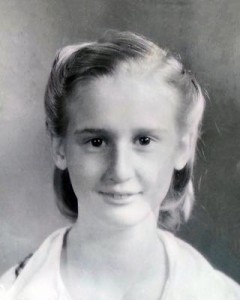
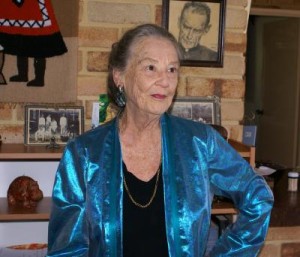
Life in Java in the early 20th century
Henriette Adriana Margaretha Thomas (nee Kuneman) was born on 22 January 1930 on the Badek Estate, a coffee and rubber plantation, near Kediri, East Java in the former Netherlands East Indies (NEI). Her father Jan Hendrik Kuneman (7 April 1885 – 9 March 1945) was born into an upper middle class family in Amsterdam, ran away from home at age 17, and spent some time in Germany and England before arriving in Java two years later. He quickly prospered and five years later was manager of the Badek Estate, a rubber plantation.
Henriette’s mother, Grethe van Waardendurg (1899–1966), was born in the East Indies. Most family members on her father’s side were born in Holland, but many members of her mother’s lineage had settled in Java several generations beforehand. She was educated a convent and learned the fine arts including painting, needle work, piano and also French which was the language adopted by higher society in Java at the time.
Grethe met Jan in the early 1900s when she was some 18 years of age. At this point Jan was just an an ‘assistant’ at Djember in the back waters of east Java and her family vigorously resisted their betrothal. The young couple, however, were equally determined. They applied for a court order to marry, were successful, and spent the early years of their marriage at a coffee plantation in east Java, some 30 kilometres from the nearest neighbour. It was considered to be a wild and isolated area. During the night tigers would come to the yard and drink from horse’s troughs which must have taken some adjustment for a young woman raised in the comfort and restraint of higher society gatherings and the fine arts. By 1924, Jan was offered the position of manager at the Badek Plantation, where life became easier for his wife. He owned shares in the plantation and later became a wealthy man.
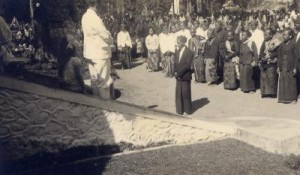
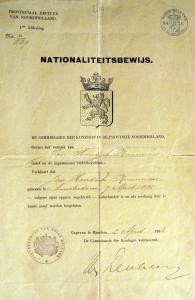
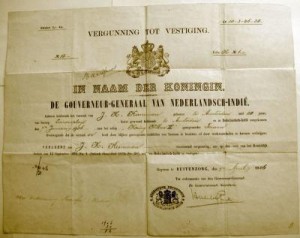
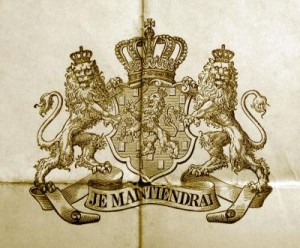
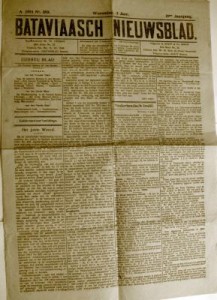
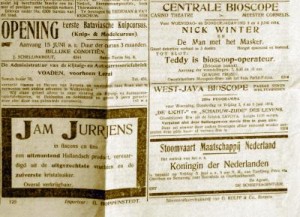
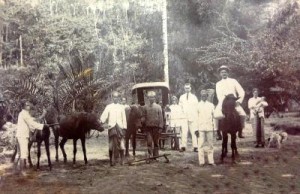
Henriette’s father Jan was a staunch Lutheran, an Elder of the church, and would sing hymns in a rich baritone voice each Sunday morning. Although a strict teetotaller and very protective father, Jan permitted his children to do as they wished on a Sunday including picnics, hiking, swimming, horseriding, attending the pictures—almost anything on the Sabbath, as long as they didn’t dance. He taught Henriette map reading, German and French poems – mostly those of Goethe, Schiller, Heinrich and Heine – which she still remembers today. She would accompany her father when he did the rounds of the plantation, sometimes by horse, mostly by foot, and he would explain the cultivation of rubber and coffee in a level of detail that was not typically imparted to a girl in the 1930s. She learned of the longevity of rubber trees, ways of tapping, and the importance of a ‘mother tree’, an exceptionally high latex producing tree whose seeds were used for future plantings.
A socialist in his youth, and a capitalist in his maturity, Papa Jan brought his own values to the plantation. He was known for his temper – with servants known to scatter in all directions on occasions – yet at the same time he introduced a number of services for the workers including a medical clinic, schooling for their children, and paid maternity leave for the female coffee pickers. He also ensured that an underprivileged child would stay with the family for two days a week. On the whole he was a fair man, and when Henriette once referred to an Eurasion boy as ‘Bluey’ – a very derogatory term in that time-frame – she was given a severe dressing-down by her father including a stern talk about racism. (Her off-hand remark also ended up in a physical tussle with the boy which left her with a ‘blood nose and a split lip’.) Papa Jan deplored racism and encouraged his children to treat the Indonesian people well. Yet there was always a discernable difference. He was very aware of his class, wished his children to remain ‘Dutch’, and sent both sons to Holland to be educated away from the ‘Oriental influence’.
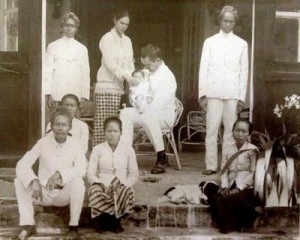
Despite her earlier immersion in society and the fine arts, Mama Grethe proved to be a resilient and stoic woman who was never idle despite scores of servants on the estate and three gardeners to help with her orchid collection. Of the two parents, Grethe was far more strict and her children were not spared the cane.
Henriette loved the freedom of growing up in this part of the world. She was an active and inquisitive child who loved animals, the outdoors and exploring the countryside around her. She was not interested in traditional feminine pursuits: she was a ‘tomboy’ her cast aside her dolls to play football, ride horses, climb trees, play pirates in the treetops, and explore the terrian with her friends who were mostly boys. She would stand her ground and wasn’t scared of a fight. If there was a disagreement, or a fight among the boys, Henriette would be in there boots and all. Her parents, her mother particularly, did not approve of her ‘tom-boy’ behaviours and spent many years trying to instil more feminine pursuits including ballet and music.
Every four years Papa Jan had long service leave and the family would return to Holland which Henriette regarded as a foreign country full of strangers who, in her eyes, had very odd habits. She commenced school there at age five which was difficult for her as the lessons were different from those at home and immediately set her apart from the children around her. She remembers being called all sorts of names: ‘monkey’, ‘peanut’ and ‘blacky’ which didn’t make sense to her as her hair was so blonde it was nearly white. On many occasions she was chased home by one of the school gangs and she recalls being thrown to the ground and her face rubbed in lawn clippings. Although feeling miserable and degraded, she never spoke of the bullying with her parents. On the positive side of her sojourn in Holland in the 1930s, she can still picture the tulips and buttercups in full bloom in the local parks. ‘Never in my life had I seen anything so beautiful, or seen anything so intensely yellow as those buttercups.’ Another important memory was her ‘relief and joy’ when the family returned to Java, leaving the country she hated behind. On one of the Long Service Leave journeys to Holland, Henriette’s older brother Kim – later a member of the joint NEI-RAAF 18thSquadron based in Australia – was left in the care of relatives for his European education and remained in the country against his wishes for the next ten years.
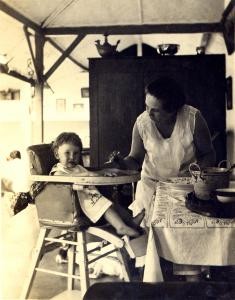
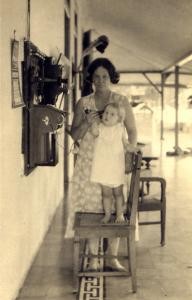
While it was important to her father that her brothers were educated in Holland, Henriette as a girl remained in Java and lived the life of an only child. Instead of sending her to the local school 25 kilometres away from the estate, her parents hired a governess. As a result she only caught up with other Dutch children occasionally given the considerable distance between neighbouring estates. They did meet on special occasions like birthdays and the yearly picnic at Popoh, a South coast beach where a group of planters and their families would gather. Her favorite picnic food was lempers, sticky rice rolls filled with curried meat and wrapped in banana leaves.
Although Henriette spent much of her time alone as a child, she was never lonely. Her Indonesian nanny, Mina, would bathe and dress her, and sleep by her bed at night. Perhaps it is not surprising that she considers herself, in retrospect, to have been a ‘wilful child’ and she recalls a string of European governesses, some of whom were unable to get along with Henriette, or her mother, or vice versa. She also had plenty of pets including four or five dogs, and orphaned chickens who followed her everywhere.
Later there was a flock of 24 sheep, cows, and a couple of old cart horses. They were her steadfast companions. However, her father complained that there was far too much stock, raffled them off to the people on the estate, and when nine-year-old Henriette came home one day they were all gone. She was broken hearted. However, the ever-feisty Henriette had been saving her pocket money, and went to the kampong (village) and purchased two goats. She tried to bargain with the locals but was unsuccessful as it took all her savings. She returned home to find Papa Jan’s temper was reaching ‘danger point’ and decided it best to return the goats without further ado. So she swapped them for two monkeys and returned home with one on each arm. This time, she was received with shocked silence—partly because full-grown, male monkeys can be quite dangerous. Once again, she had to return them. Perhaps the governesses were pleased the animals had gone as there there were too many interruptions during lessons when Henriette would find some excuse to check on a barking dog, to tend to an orphaned animal, which she now recognises would have driven many of those teaching her to ‘distraction’. When Henriette developed a recurrent chest infection, she was sent with a governess to a property at Pudjon higher up in the mountains in east Java. She recalls a beautiful mansion, lawns for croquet, and several acres of Valencia oranges.
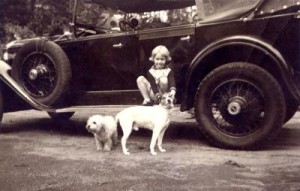
After lessons from 7–9am, Henriette’s new governess would take her out horse riding, followed by a mountain walk, lunch, more lessons, plus a game of croquet or more horse riding. If there was an orphaned or sick animal to be looked after or fed this governess – who Henriette loved dearly – would find a way of fitting it into the teaching schedule. She was less rigid in her concept of a ‘suitable’ education and Henriette was never bored during this time. There was however, tension between Mama Grethe and the governess, and as a result Henriette was enrolled at a local school. She was nine years of age. From that time she had to comply with strict school hours, stern teachers and learn to adjust to a peer group. She must have fitted in well as she was not bullied as per her earlier schooling in Holland, but when Mama Grethe sent the djongo (house boy) with a jug of iced orange juice on a silver platter at morning recess she felt extremely embarrassed. She coped with this ostentatious display by offering the platter to her classmates. ‘Instant popularity!’ she said. ‘The orange juice and the fact that it was discovered that I could play football – the school team was a player short and I volunteered – totally changed my life at school.’ Her parents, however, were far from impressed and attempted to restrict Henriette’s time on the football field and in the swimming pool by introducing piano and ballet lessons. When this proved ineffective they placed a total ban football. Henriette was as determined as her parents, sneaking out to the football field and returning home with ingenious ways of explaining grazed knees—not always successfully!
The clouds of war, 1939–1942
This was 1939 and war had broken out in Europe which seemed so very far away from a rubber plantation in Eastern Java. Henriette explained that:
… It did not touch us in any way. We were very interested in Spitfire fights and naval battles and used to cut out the pictures from magazines and swap them with each other at school. We used to spend our pocket money on second hand magazines, cut out the fighter scenes and naval battles and had a brisk trade amongst our peer group.
By 1941, Dutch colonialists began to set up air raid shelters in their properties, yet the threat of war was obviously not taken very seriously at this point as few would follow the drill when the sirens sounded. On one occasion in the middle of the night, Henriette recalls burying her head beneath the pillow to muffle the sound. She also recalls sitting on the bed at school licking chocolate letters during a Sinterklaas celebation, when she heard of the Japanese attack on Pearl Harbour on the wireless. The blow had fallen, and soon after the Netherlands East Indies Government was drawn into war. Her parents then removed her from school and took her to the safety of the plantation and initially Henriette was delighted to be home to stay. She was enrolled at the local school, some 25 kilometres from the estate, and would rise at 5am each morning for a 7am start. Her father built ‘a whopper of an air raid shelter’ and the warnings would be delivered by phone. One of the servants would then sound the tong tong, a hollowed out tree trunk, with eight long and three short knocks which was the sign of an air raid warning. They would take shelter, but for the most part the raid never came. So they would spend their time under the trees, just outside the shelter, with a picnic. Sometimes it was a prolonged picnic as while warnings were always rung through, there was rarely an additional call to let people know that all was clear. Henriette experienced two air raids. One was at the local school where the children were directed to sit under their desks with an erasor between their teeth. They heard the screech of the Zeros overhead, but no bombs fell. The second was in the middle of an Agave field when the chauffeur herded the children underneath the car, and from that point in time travel was curtailed and they no longer attended the local school.
By 8 March 1942, the Netherlands East Indies capitulated to Japanese forces after a week of intense fighting. Nobody was sure what was happening, but they were aware that Japanese forces were descending on Java from Singapore, efficiently and strategically riding their push bikes – which had been parachuted to ground – down the Malay Peninsular. The knowledge trail was fuelled more by the bush telegraph than by clear fact. There was panic and hysteria as rumours circulated that the Indonesian people – led by the Japanese – were looting and plundering plantations. The Kuneman family packed their cases and were ready to flee to Australia when Papa Jan decided that ‘a Captain never leaves his sinking ship’. Neighbouring planters urged him to leave, but he realised there was nowhere to go, that if they went to the city, by the time they arrived, that too would be bombed. He then gathered the remaining neighbours into the house where everyone took shelter. When the kabir angin (news by wind) circulated that Indonesian hordes had reached the property boundaries, there was total confusion and panic. It was a noisy, chaotic situation in which Papa Jan took charge by gathering the planters and their families onto the estate, ordering self-control and silence. He told them that as long they were in his house he would make the decisions and he prepared for the evacuation of women and children to a protected area well away from the central compound. He told the planters to arm themselves and then asked if there was another gun for him. (Ironically, he didn’t own a gun as hunting had always been forbidden on the estate.) He divided the men into groups, with several men assigned as sentries for the women and children. He then addressed the plantation workers, explaining that if they had thoughts of joining the looters he could not stop them. He pointed out that if they did, he would be placed in a position in which he would need to defend the house and factory, and strongly urged them to help ward off the looters to keep the factory intact and to be assured of future employment.
Henriette was 12 years of age at the time, had no idea of events around her and what was to come, and viewed the situation with a certain amount of excitement. In the rush of evacuating the women and children, no thought was given to food and provisions, and it was Henriette who quickly filled a sheet with tins of food, bread, butter, and anything else she could easily lay her hands on. She did well until the last moment when she decided to include a number of uncooked eggs which broke on the journey covering all the provisions in layers of ‘goo’. The women and children were only away overnight as the Indonesian people gathering at the borders of the estate dispersed quickly, with the possibility that Papa Jan’s stern speech to his factory and plantation workers had played an important part. In contrast, those planters who left their estate to take refuge with the Kuneman family returned to their various plantations to find their houses and factories devastated, their furniture destroyed or looted. The news that travelled in the wind circulated within and between the plantations indicating rape, destruction and plunder by invading Japanese forces. Soon after, Papa Jan received a phonecall from a neighbour warning him the Japanese were on their way, a warning accompanied by loud cheering from the workers in the kampong in an understanding that the ‘liberators’ had finally arrived.
The truck finally reached our house, followed by hundreds of cheering Indonesians, when a colonel jumped off, approached Papa with outstretched hand and said: ‘Hello Mr. Kuneman. How are you?’. Papa was so stunned that he took the offered hand and to his great amazement discovered that this colonel was the wood merchant he had been doing business with for many years.
The Colonel/wood merchant told Papa that he had come to confiscate any fire arms Papa may have had in his possession but, looking at the throng, then told Papa that it would probably be prudent if he kept them, at least until the volatile situation had subsided a bit. With these words he jumped back onto his truck and they drove off. Such an anti-climax!
The Japanese fifth column in Asia was well organized. For many years they had been present as little shop owners, wood merchants, nursery men or whatever. A few months before the Pearl Harbour incident all these people were recalled to Japan; they were leaving in droves (Henriette).
The next visit by a Japanese official was the newly-appointed Mayor of Kediri. Henriette remembers him as a ‘small and polite man’ who consficated their De Soto limousine and their petrol supplies. Ever resourceful, Papa Jan bought a horse for their disused old buggy and dog-cart so they could shop for supplies in Pare, a township 25 kilometres away. Attending school was impossible, so Papa Jan taught Henriette French and German and before long Henriette could read books in the French and German language. Although he was also fluent in English, this was a language he chose not to teach as he felt his pronunciation was far from perfect. Semi-formal schooling was introduced when a teacher whose husband was sent to a prisoner of war camp, was taken in by neighbouring estate. The pupils at this little school were all boys Henriette’s age or a little older and they would also go in to the jungle with their panga’s or klewangs as they were called over there and hack their way through the undergrowth. They would also carry a stick to ward off the rhesus monkeys who not only were bothersome but were known to attack people:
There was one rather hilarious incident when we encountered a family of wild pigs, a female with her litter of piglets. She was very vicious and we all had to scramble to safety and find a tree to climb in. We could not stop laughing but when after a couple of hours she was still underneath the tree watching us with her beady eyes there was not much hilarity left. It became very boring and we were getting cramps. We were stuck in the tree for hours, it was not until dusk that the sow gave up her vigil and quite dark already when we reached home. We did not get a very pleasant reception and were grounded for a long time (Henriette).
Back at the plantation, Papa Jan cut down the majority of the latex bearing trees as rubber was an important commodity to the Japanese forces. He planted maize in their place. This act of sabotage became known to the Kempeitai (Japanese military police) who sent a number of officers to the estate to investigate the act and to punish the perpetrator. At the time, the family had no idea of the ferocity of the Kempeitai, and received them without fear. The officers were offered refreshments, a tour of the house—the only thing obviously amiss being the clock which was set for local time rather than Japanese time as decreed, one-and-a-half hours ahead. There was a very uneasy moment as Henriette’s mother owned up to this transgression. A Japanese officer took out his revolver, pointed it straight at her, and she lived to tell the tale. They then directed their attention to Papa Jan regarding the removal of the all-important latex-bearing trees. He argued that the trees were old, that rice was scarce due to war, that it was his role to look after the workers and people on the plantation, and that the maize had been planted to feed them. The officers were dubious but the argument was good.
Later in the year, there was another nasty and unsettling incident. The dogs were restless and barking a lot, which was often happened during a time of earthquake. In 1919 a whole town had disappeared beneath the lava when Mount Kloet erupted, but since then quakes had been minor and people were not that worried. But in the middle of the night the family was woken by barking and the sound of shattering glass. There were 10 to 12 intruders demanding money and Papa Jan was thrown to the floor as he tried to ward off blows from a klewang. Henriette and her mother managed to flee from the house and ran to the kampong to arouse the workers on the estate and hit the tong tong [gong] as hard as possible to draw the attention of others to the scene. A posse was quickly formed intercepting the assailants just as they were leaving with the money. Papa Jan needed medical attention, but as taking the main road to town would be risky, they decided to make their way through the rubber plantation via the light of the full moon. They got totally lost, and in the end it was Pico, one of their pet dogs, who guided them in the right direction. It was fortunate for the Kunemans that the Japanese were displeased that such an incident would take place on the sacred day of the Emperors, Tenno Heiko’s birthday, and they undertook an intensive search for the Indonesian assailants. Many were caught and much of the money was recovered. In considering the safety of his family, Jan sent Henriette, together with her mother, to an aunt and uncle who lived on a sugar plantation outside Kediri. Henriette had fun there: there were parties, games, and she loved the company of her cousins. Yet her boisterious tomboy behaviour and her sense of adventure – including forbidden forays in the afternoon siesta – were just too much for the quiet and sedate ways of this very traditional family. It was many years later when in Holland that her aunt spoke of her delight and relief upon their departure.
Life on the estate in 1942 was tense and uneasy. Unlike many other families, their wireless had never been consficated, but a seal had been placed on the short wave knob limiting their access to news from the outside world. However, family members found a way to remove and replace the seal undetected, and they would rise at 5am to listen to the BBC. To hear the voice of Winston Churchhill was a boost to morale, yet they still had no idea of the manner in which the war would unfold around them. Later they found that at least two of the workers were informants. After Indonesians had invaded the plantation earlier that year, Papa Jan placed the bullets left by neighbouring planters in a tin and buried them in the ground when he should have handed them into the Kempeitai. He thought this to be the less risky option. However, a gardener-come-informant planted a tree as a marker over the buried tin and when the Kempeitai from Pare arrived soon after, he was seen leading them straight to it. They uncovered the bullets and then entered the house to scrutinise the wireless. Fortunately for the Kunemans the seal ‘appeared’ intact and the officers left with the bullets, telling the family they would more about this matter. Papa Jan was very concerned as the reputation of the Kempeitai – the military police arm of the Imperial Japanese Army – had spread fear and trepidation, their actions akin to the secret police of Germany’s Gestapo. He made a strategic decision: instead of waiting for their arrival, he took the train and gave himself up to the Kediri office of the Kempeitai. (It was the Pare office that had found the bullets on the estate.) It is difficult to say how Papa Jan survived, but he was aware of the tensions over jurisdiction between the two Kempeitai offices, and he was never bothered from that day. At the same time the family were very wary, and astutely left the wireless alone as they could never be sure which of the workers might be police informants.
Henriette’s brother, Jan (named after this father) was interned in early 1942, but other family members still had freedom of movement. But this was a ‘freedom’ immersed in uncertainty and risk. For example, when Henriette’s sister Gonnie and a friend went into town – each wearing the obligatory Japanese flag on their arm – they witnessed a Dutch woman being forced to undress by Japanese soldiers. This callous exploitation was intercepted by a Japanese officer who viewed and assessed the situation and shot the two offending soldiers.
Circumstances and conditions were unpredictable and volatile, and the family was not surprised when they heard they too were to be interned. Henriette remembers Papa Jan and Mama Grethe hand in hand, walking around the plantation, saying goodbye to their beloved home. This was November 1942 and it was the last time her parents would be together. Jan died of starvation five months before the war ended, and they never saw Badek Estate again.
Internment in Java: Kwarassan, Banjoe Biroe X and Banjoe Biroe XI
Women and children in the area (including young boys up to 10 or 12 years of age) were interned in Kwarassan, in the compound of an old sugar plantation not far from Badek. The men, including all the male planters in the area, were interned in a Kediri jail. Henriette was nearly 12 years old and had no idea of events to come. Initially she was pleased at the prospect of catching up with old friends, and they travelled by dogcart to Kwarasan, along with their goods and chattels, and were allotted a house to be shared with four other families. The conditions were relatively good and they were able to buy provisions from a local shop and the daily market at the camp gate. Workers from the estate would deliver fresh milk and other articles they had forgotten to pack. On the down side, school was forbidden, so the children formed a football team and undertook ballroom dancing lessons. Henriette thoroughly enjoyed herself until she developed multiple infections in the sweat glands of her arm pit, and had them lanced, one by one, with a razor blade without any anaesthetic. It was not long after their arrival that a high-ranking Japanese officer demanded that Henriette’s sister Gonnie bow for him. She refused and he raised his Samurai sword and forcefully whacked the flat blade over her back. From a distance it looked as if she was being decapitated. The realities of life in a POW camp were starting to set in.
In early 1943 the women were informed they were to be moved to another camp. They were to travel by train and were permitted a certain number of suitcases along with food and water for the journey. When they arrived at the station it was as if:
… all hell had broken loose. It was absolute pandemonium, screaming Jap soldiers shoving us forward with their riding crops, sweeping the air and us with them. Women were crying children were screaming. Oh, what a sheltered life had we been leading, it was a rude awakening (Henriette).
Family members – Henriette, her mother Grethe, sister Gonnie, sister-in-law Nancy, three nieces and one nephew – were separated and herded onto the train like sardines. Doors and windows were shut, it was stifling hot, difficult to breathe, and yet they remained at the train station for several hours. The thirst was unbearable. At the beginning of the journey they tried to keep their spirits up by singing songs, telling stories, and making bets as to where they would end up. However, as the night went on, normal toiletries were impossible, the conditions in the carriage worsened, and morale went down. Some of the guards took pity, provided water, and when they permitted the women to open the shutters they could see the beauty of the mountains and jungle before arriving at Ambarawa in Middle Java. They were then transferred from the train to the trucks ‘none too gently’ and transported to ‘Banjoe Biroe’ which, translated from Indonesian, means ‘Blue Waters’. The name may have been poetic, but this was no lake—it was a swamp, a breeding ground of the dreaded malarial mosquito. The compound – known as ‘Banjoe Biroe X’ for the duration of the war – was formerly an army barracks and before that a prison; it had high walls, buildings with barred windows, the sewerage ran straight from the toilets to open gutters, and the smell was described as putrid. On arrival, they queued for several hours to be processed and registered and were then billetted alongside pale-faced women who had been interned since capitulation. This reduced the living space considerably and the new arrivals were not greeted well. In later years, they understood for they too could begrudge incoming internees who took up limited resources. Henriette and Mama Grethe were among some one hundred women allocated a horse stable that they would all share for the next year. They slept shoulder to shoulder on wooden frames — a double row of women along each wall and a double row down the centre – together with a sign on the wall that read, ‘home for homeless bed bugs’. There were holes in the ground serving as toilets, two rows of ten holes side by side, with no partitions. Nancy, Gonnie and their children who had been interned in a barrack on the other side of the camp faced similar conditions. The open air ‘bathroom’ was a large cement tub where the women could throw water over themselves with a container overlooked by soldiers in the surrounding guardhouses. In this set up, there was no personal privacy.
Henriette felt she had been catapulted from a ‘happy carefree childhood’ into a ‘cesspit of human misery and degradation’:
On that first day a Japanese officer came to the stable and told us that from now on we were under the care of the Imperial Japanese Army and if we kept to the rules and behaved ourselves all would be well. However, if we broke those rules the punishment would be severe. He also told us that twice a day there would be ‘appel’ (roll call), at 7 am and 5 pm and everyone was expected to attend, children and the sick included.
He went on to say that when a Japanese officer or soldier approached we had to stop everything we were doing and call ‘kere’ (stand to attention), followed by ‘nore’ (bow). When the person had passed we had to call ‘yashe’ (at ease) and could go on with what we were doing again (Henriette).
The women would bow as demanded but as they bent forward they would look the Japanese soldier or officer straight in the eye. It took several beatings before the women learned to comply. There was a roster for cooking duties and initially the food was plentiful (although lacking in salt) but it was just a matter of weeks before the women were subsisting on a starvation diet. There was tapioca cooked in water together with an insipid tea for breakfast, a cup of cooked rice and two spoonfuls of watery cabbage for lunch, and for dinner a ‘tiny horribly grey looking loaf of bread’ that was allocated to each family on a weekly basis. Additional rations consisted of two spoonfuls of sugar a week, and a banana and half an egg each month. Henriette’s mother came down with beri beri, her condition aggravated by constant dysentery and the bodily deprivation of sharing her meagre rations with her daughter. (In retrospect Henriette feels a little guilty, until she remembered that at a later point she was able to gather provisions for her mother including rice and coffee.) The women banded together to help each other. One managed to steal five large red chillis from the kitchen each day with the result that Mama Grethe was free from beri beri and the dysentery within a month. Others were not so fortunate, for many women died each day.
One woman in her late thirties had the courage to raise the conditions with the camp commandant. But she then ‘disappeared’ for a couple of months, returning to the stable as ‘an old woman and a total wreck’. She never spoke of what exactly happened to her, but the others knew she had been tortured:
A favourite pastime of the Japs was the water torture. Water was pumped into the body from both ends, when totally swollen a soldier would jump on them. I won’t go into other methods, but there were many and the sound of screaming women coming from the cells was hard to forget (Henriette).
Within six months of internment, there was a diptheria epidemic and although the women were aware that Red Cross supplies of vaccine were available, the Japanese soldiers refused to release them. Many children died, with one woman losing five of her children within the one week.
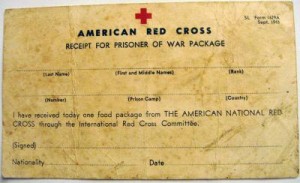
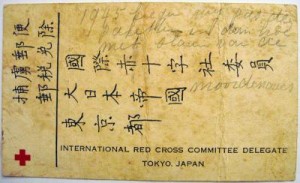
To help ensure that packages reached the internees, a signature was required by the Red Cross, but too often the packages did not reach them. In the second image, one can see Grethe Kuneman’s handwriting lamenting the delay, referring to the Japanese as ‘Murderers!’
This was a very ‘depressing year’ and when the women heard that a couple of hundred inmates were to be transferred to another camp, the Kunemans took a gamble and volunteered for transfer. No details were provided about the other camp, so it was a big decision at the time. As they left the compound with its barred windows, the smell of freedom and fresh air – albeit short-lived – was indescribable:
The trucks arrived and to our amazement only our baggage was loaded on. Shortly after we received the command to start walking. This was even better as we could enjoy our freedom for a longer period. Everyone was in a picnic mood, smiling women carrying their bags, rucksacks on the back, joyous children with their dolls and teddy bears, all in file breathing in the fresh air (Henriette).
They walked for a few miles to a smaller camp – ‘Banjoe Biroe XI’ – that was surrounded by a bamboo fence rather than high walls. Once again they were processed and registered, and then taken to relatively spacious barracks surrounded by huge canary nut trees shading the compound. ‘Everything looked neat and tidy, it actually gave out a friendly atmosphere.’
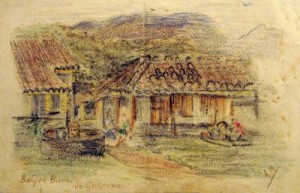
The seven family members shared a small room with two women and four children and although there was limited sleeping space, they thrived on the luxury of some privacy after the deprivations at the previous camp. The food was insufficient but better prepared than the ‘slop’ provided for them in the previous year. Further, there was a special diet kitchen run by interned nuns from Yogyakarta who prepared special food for babies and invalids. In this camp, the children were not listless and it was a pleasure to see them play, sing and dance in the kindergartens run by volunteers. School for the older children was strictly forbidden, although lessons in Latin, English and French were run on the quiet by former teachers.
The Kunemans congratulated themselves in making the right decision to shift camp and all went well for several months until the Camp Commandant was replaced by a member of the Kempeitai, who would soon be regarded by the women as ‘an absolute animal’:
He would strut around the camp and if the bowing was not deep enough or not to his satisfaction, he would slap us with his riding crop. Rations went down considerably. Water was turned down to a trickle during the day and one had to spend hours in a queue to fill a bucket. Hygiene went down, people stopped using sheets and slept instead on bamboo mats (Henriette).
Henriette’s mother found that the water flowed well at 3 or 4am, and would rise from bed, wash herself, fill every container she had, and return to her room. She would then bathe the children and wash the family clothes.
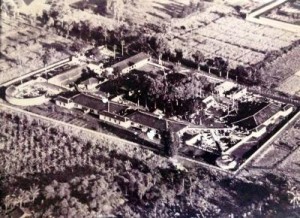
After a new group of women arrived at the camp, the conditions deteriorated, and there was an outbreak of typhoid. When sister-in-law Nancy Kaulbach contracted the disease, Henriette would steal two torpedoes (eggs) from the kitchen when on cooking duties, to help with her convalesence.
Visits by high ranking officers were frightening. A couple of days beforehand, women would be issued with blunt knives to cut the grass—a sure sign that such a visit was imminent and precious articles such as jewellery, quinine or other medicines were immediately hidden. On the day of the visit, the women would stand in ranks for several hours listening to one speech after the other as soldiers searched their belongings. One one occasion, Henriette’s five-year-old niece was standing directly behind her and was suffering from prolonged exposure to the sun after being forced to stand the whole day. Henriette suggested she hide under her skirt until the parade was finished, and decades later her niece could still recall in detail the colour and condition of Henriette’s knickers. Another of her nieces cannot recall anything about the war—she has blocked it all out. Henriette, however, has amazing recall.
There was only a handful of Japanese Guards, including the Commandant, the rest of our guards were Javanese, trained by the Japs. We used to call them ‘Hi Ho’s’, but I cannot remember why we gave them this nickname. Some of them were not too bad, but at times the camp Commandant would severely beat them. I remember one who had his eye hanging out after one such beating. They would then be sent out into the camp and given orders to give us the same treatment, which given the consequences if they didn’t, was done with great fervour.
Another punishment the Japs dreamed up for us was to give extra rations and then withhold the wood so we could not cook, or give us plenty of wood for cooking and cut off or reduce the rations.
If the Commandant thought we didn’t have enough to do or were becoming lazy, we were ordered to carry boulders from one side of the camp to the other and then back again. These were quite heavy and in our weakened condition, not easy to carry, it was a frustrating and senseless occupation (Henriette).
At one point, the women were ordered to cultivate a strip of land between the bamboo fence and the buildings and under much duress were given three weeks to prepare a vegetable garden. They planted vegetables, papaya trees, and chilli plants and even though they were patrolled by the guards Henriette decided to raid the garden in the middle of the night. When the guards returned earlier than expected, she lay flat on the ground with their feet passing close to her face, grabbed the first chillis she could find and, heart pounding, jumped an open sewer, hurrying back to the safety of the room. She was so disappointed to find the chillis she grabbed in haste were not fully grown, they were only green. She was far too scared to venture out again. But her sister-in-law Nancy did, and successfullly returned with two ripe papayas which provided a feast for all that night.
The women spent much of their free time playing bridge and talking about food and recipes which claimed extra importance when food was in short supply. Sleep was lost through hunger pangs, and dreams were not of restaurants and gourmet food but of plain and hearty bread and cheese. In most camps, there was trade between Indonesians and internees with food smuggled across the fence. The camp commandant caught on and, yelling at the women as they stood on parade, let the culprits know that if they did not own up, he would punish the whole camp. When there was silence, he ordered the young women to come forward and kneel in the gravel until sundown. The elder women stood in the full sun, as the commandant ‘continued to yell and deal out blows’.
By the end of 1944, conditions had gone from bad to worse. More and more women were brought in from other parts of Java, and every day there were more deaths among those in younger age groups. Much of the older age group had already died. Mama Grethe was very focussed: she rose each morning, did her washing, carried the water, bathed the children. She was determined to survive. In this same year, conditions began to change in unexpected ways. On 27 January 1945, a plane clearly marked with the Dutch flag flew over and released pamphlets. The wind blew them away from the camp, but they were encouraged that an allied plane could fly over in broad daylight. Perhaps the war was over? They later heard that the pamphlets were telling them that they were not forgotten, and to keep their chins up. By May 1945, the Japanese had become more lenient with the women, and permitted them to go outside the camps to forage for food and to treat the sick. Gonnie would collect herbs and berries from particular trees to start a herbal kitchen for the sick and ailing. Henriette would sometimes go out with her to gather the big Agave snails, a rich source of protein. They would be soaked in a bucket of water over night to release their poisons, with the ‘horrible job’ of crushing and washing them falling to Henriette. After being cooked, they were put through a hand-grinder, and each person would get one teaspoon each. Henriette hated it. It tasted awful and she took it in the same way as medicine. On the positive side, she feels that it was instrumental in curing her from dry beri-beri. She then contracted hepatitis and was admitted to the camp hospital where the remedy at the time was to kneel for a high bowel enema with cold water. ‘Disgusting’, she said. She was in the hospital a week, and was horrified to see sugar rations re-allocated and gold teeth removed after each death. At the time, she was not aware that this was a tactic employed by many POW camps to help provide much needed resources for others to survive. What ever the truth of the situation was in this instance, Henriette has never forgiven them. During this time a small boy was brought in who was so ill that he was not expected to survive:
As soon as news of this went around the camp, everyone went outside, kneeled down and prayed. The whole camp, every creed and religion must have been out there. From my bed I could see the cot of this child and to me it did not look too good, however, miracles of miracles he survived.
This experience made a great impact on me. For a long time I believed in miracles and the power of prayer. In times of such need that the people could forget their own misery and sorrow, forget the feuds with their neighbours and come out as one to pray for someone else’s child. It certainly restored my faith in human nature (Henriette).
Japanese capitulation and the Indonesian Revolution
After Hiroshima and Nagasaki were bombed in early August 1945, the Japanese capitulated. It took several weeks for the news to reach the women at the Banjoe Biroe XI camp, and several months for them to fully comprehend the horror of the bombings that shortened the war and saved their lives. All Henriette knew at the time was that scores of women began openly smuggling and buying food through the bamboo fence. This was late August 1945. It was extraordinary, not one Japanese soldier was in sight. She was quick to join the women. As she traded a dress for eggs, the women were told by the Indonesians that Japan had capitulated, that the war was over, and that they could return to Holland as the country now belonged to them. The winds of change had started.
At that point the women were not worried about whose country Indonesia was or if it was the end of the world. Their only concern was to start eating and go on eating and eating. For many, this ‘manna from heaven’ came too late—they were too weakened and their systems no longer able to digest the food and absorb the nutrition. There were also a few deaths from eating too much too quickly. When the Japanese commandant appeared later in the day, he informed the women of the Japanese capitulation, and explained that the Allies had ordered him to look after them until Allied Forces reached the camp:
With great pomp and circumstance the women took down the hated Nippon flag and hoisted the red, white and blue Dutch flag. Whoever owned this flag should get a medal as it must have been quite a feat getting it through the searches. But, 24 hours later, a group of Indonesians came, took down our flag and with great pomp and circumstance hoisted the red and white Indonesian flag. So that was that. The next day, truckloads of meat and fresh vegetables arrived, compliments of the Chinese Red Cross (Henriette).
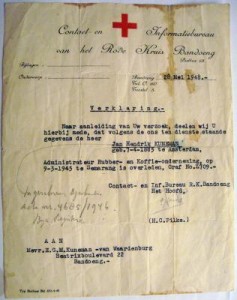
The following day Henriette and a couple of friends left the confines of the camp, and began to explore the surrounding terrain. Initially there was no problem. The Indonesian people were just as elated as they were at the Japanese capitulation and there was good will towards the three young women. There were several POW camps in Ambawara and Henriette, Gonnie and Nancy went to town to try and locate their respective fathers. They could not find Papa Jan (he had died of starvation on 9 March 1945) but they did locate Nancy Kaulbach’s father, who was so emaciated he looked like a skeleton. They did everything possible to provide nutritious food, but he died a couple of days later. On their travels around the camp, they heard ‘horrific’ stories of torture, too ‘dreadful and gruesome’ to be included in an online story.
The Indonesian people vigorously asserted their independence, and as the situation escalated, the women were confined to the camp for their own safety. It was too dangerous to venture out on the streets. They had to wait for Allied Forces to reach them but with more than 200 Japanese POW camps scattered throughout South East Asia, this could take anything from weeks to several months. Henriette does recall Allied planes flying overhead parachuting medicine and big loaves of white Australian bread into the camp. These air-drops must have triggered an emotional cord as many of the women cried and prayed as the provisions floated to the ground. But on landing, there would be an almighty tussle between the women for the parachute which was a valuable and useful commodity at the time as they were made from pure silk.
The family made the decision to leave the camp and return to the plantation before Indonesian dissent spiralled further. The plan was to take a train from Ambawara to Surabaya and from there a train inland to Kediri in East Java. They packed their few remaining clothes, made a bonfire of the bedding (and with great delight heard the bedbugs pop and crackle), and then set off for the station. They boarded the train and found two Japanese armed guards on each wagon with their new role – as directed by Allied Forces – to maintain peace and order. It soon became clear why the guards were there. As they looked out the windows, groups of Indonesians were standing to the side of the railway line, yelling obscenities at the Dutch, some hurling stones. There was surrounding gunfire as the train arrived at Surabaya and uniformed Indonesian men boarded the carriage to take the Kunemans and others – utilising Red Cross trucks – to a house in a residential area occupied by a Japanese officer. The officer constantly bowed to the women before being removed by uniformed Indonesians. What happened to him is unknown. They were advised by the Red Cross that onward travel to Kediri was impossible as gunfire was rampant throughout the region and where, in their own estimation, ‘all hell had broken loose’. Henriette’s aunt and cousins had undertaken the same journey a day earlier, made it to Malang, but were then intercepted and interned by the Indonesians, and released 12 months later.
Battle of Surabaya
The Kunemans were comfortable inside their allloted house in Surabaya. Their Indonesian neighbours were very friendly and a market and shops were nearby. The neighbours invited them to witness a public execution of Japanese soldiers, but the family declined. However, this was an unpredictable climate steeped in reprisals and rapid change, and very soon they were no longer permitted to shop at the market, and placed under virtual house arrest. They were given meals, but the standard was far worse than the food provided in the first camp at Kwarassan. Henriette attempted to leave the house but when confronted by a young Indonesian soldier pointing his rifle at her, repeatedly telling her to turn back, she thinks it may have been the fastest she has ever run in her life.
One morning an old acquantance unexpectedly came by, calling out: ‘Smile, smile, the British are in the harbour’. Everywhere there were truckloads of British officers and Ghurkha soldiers who wanted to concentrate woman and children in just the one location in Surabaya that would be easier to defend in open hostilities. The Kunemans were allocated the third of three convoys – but in the confusion placed in the first – which passed through the town without mishap before being ‘detrucked’ in front of a beautiful mansion with a marble staircase that once belonged to rich Chinese residents. They were delighted at such opulance, but within minutes of exploring the rooms, they were told they were in the wrong house. It was already occupied by women and children who, it was rumoured later, became a human shield for Indonesian forces. The 550 women, children and Ghurkas who were placed in the third convoy were killed in what was described as a ‘massacre’. Hand grenades had been thrown into the trucks and those who jumped out were impaled on sharp bamboo stakes.
The family was taken to Raya Darmo Street with the Darmo Hospital located on one side with a row of houses on the other, and a kampong directly behind. The sign in front of the cottage allocated to them stated that it belonged to the British-occupied hospital—a distinguishing feature that would later save their lives.:
During the next week I learnt the taste of mortal fear. Not once, but several times we were in grave danger. Whilst the fighting was in progress, mortar rounds fired by the Brits were screaming over the house. This was answered by rifle fire from the Indonesians (we were the meat in the sandwich). This did not worry us so much; it was the eerie silences in between the exchanges of fire which were hard to take (Henriette).
In the midst of the turmoil, the ordinary tasks of life had to go on. Henriette and Nancy would wait for a lull in the fighting before hanging the washing on the line, towels slung over their shoulders, pegs between their teeth, anticipating the bullets that would scream past their ears. It was all to close for comfort.
The support of Allied Forces, particularly the Ghurkas, was valued greatly. Each night a Ghurka soldier, with knife between his teeth, would crawl on his belly from the hospital to bring them food and provisions. On the third or fourth night of the fighting, Indonesians climbed the wall of their neighbours’ house, and in the offensive a woman was locked in a cupboard and screamed for the duration of the night. There was nowhere to run, nowhere to go, and all the Kunemans could do was to huddle together waiting for their turn to come. There are no words to describe how Henriette felt that night, and she still finds the feeling of ‘no escape’ impossible to take. For years after the war she was plagued by nightmares, of walls closing in on her, from which there was no release. She would wake screaming, two or three times a night, just like the woman who was locked in the cupboard. The family all reacted in different ways. Nancy and her son ‘kept their cool and played the clown’; sister Gonnie was a ‘nervous wreck’, Mama Grethe sat ‘silent and stoic throughout the whole ordeal’, and Henriette got ‘sloshed’ on bottles of Arak, a locally distilled alcohol, that she found inside the house.
A week later there was a ceasefire and the fighting stopped as Indonesians, Australians and the British met to talk. Henriette took advantage of the lull in gunfire to do some repairs on the house. It appeared that the water pipes had been hit by a mortar round, so she grabbed a ladder to scale the walls of surrounding houses in a search for water. At the top of the ladder she glanced across the kampong to see three men with rifles pointed directly at her. She immediately dropped to the ground as three bullets whistled over the wall. This time she was not frightened. Perhaps the adrenaline had kicked in for all she could do was laugh, delighted that she had been too quick for them. As I read this back to her, she still chuckles about this time for it was one point in the war where she was one step ahead. Later that day, a truck stopped in front of the house—it was filled with Indonesians armed with rifles and bayonets:
Again we had to go through terror filled moments. They marched to the front door, stopped and had a conference about the sign on the door. Meantime we were quiet as mice; even the children did not utter a sound. Finally, conference over, they decided that it would probably be prudent for them to leave as it said that the house was under the protection of the hospital (Henriette).
After this incident, the Red Cross informed them they would be evacuated to Singapore. So as not to alert Indonesian revolutionists, they were told not to take any of their belongings, that they had to go just as they were. They were further advised that if stopped, they were to tell the Indonesians they were going to the British post in search of food. Accordingly, they left the compound in bare feet, passed through several check posts, arrived safely, and then slept the night on the floor. Thousands of women and children would soon join them. They boarded trucks to travel to the harbour, remaining absolutely silent during the trip, no talking, no sneezing, no sound at all, no matter what the circumstances. Further, there were no armed guards to protect them—a condition, they were told, of their travel. They could not risk triggering off another violent incident. With the Indonesian revolution in full thrust, and the hatred towards the Dutch so tangible, even the smallest children remained silent. Henriette still gets shivers remembering the gravity of that time. When they arrived at the harbour, they were taken by landing craft to two British troop transport ships. She is not certain, but thinks they were the Balula and the Ekma. The ships were ‘bursting at the seams’ and they had to sleep on the decks in the midst of squalls of rain. This was very uncomfortable, yet they did enjoy the Irish stew and ship biscuits which tasted absolutely delicious after no food for two days. Rumours spread that ‘Surabaya Rose’ – the local equivalent of ‘Tokyo Rose’ –managed to board the ship, leaving many people fearful of pending sabotage. Henriette, however, was more concerned about sailing through thick minefields that were bobbing up and down in the water. It was so dangerous that it took five, rather than two to three days, for the ships to navigate their way around the mines and arrive safely at Singapore.
Evacuation to Singapore, November 1945
Singapore, beautiful Singapore! At long last the war was over for us and we were safe. The date was 9th November l945, more than two-and-a-half months after the war had ended. There was great joy but also a lot of sadness around us. The joy of having finally arrived safely, the sadness for our friends and family who never made it (Henriette).
They disembarked relatively quickly as they were displaced people wearing all their worldly possessions. They were housed in the Wilhelmina camp (named after the Dutch queen) who took an active interest in their welfare. The Kuneman family received a letter from Queen Wilhelmina in late 1945 (see image below) which acknowledges the bravery of the women and the horrors they went through.
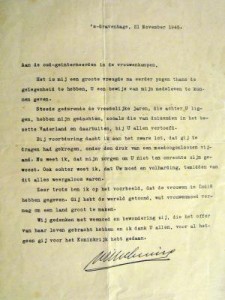
In a very short time, Wilhelmina camp became known as the Wilde Mina camp as many women, after some five years of deprivations and hardship ‘made up for lost time and not necessarily with their own husbands’. There were thousands of troops in Singapore of every nationality and Henriette, like many others, ‘were all agog’.
Once again they were alloted a house and as they entered they spotted names that previous residents had written on the wall.
Suddenly there was a cry from Nancy who was reading out the names. We all rushed to her and there amongst 20 names was the name of my brother Jan. At what time he had put his name there we had no idea, but Nancy rushed to the office and contacted the Red Cross. It did not take long to find my brother, who had been imprisoned in Changi Jail during the war (Henriette).
She still thinks this is amazing. ‘Of all the houses we could have been placed in, we were allocated the very one where my brother had signed his name on the wall.’ Soon after they heard that Gonnie’s husband Bauwe was being processed by Americans who liberated him from the infamous Burma Railway and he too was on his way to Singapore. They did not know at the time, but her younger Kim had been demobbed and was making his way to Perth, Western Australia. This was the time of re-union for a great number of former internees:
… sometimes happy ones, sometimes not so happy. Children did not recognize their fathers, husbands returned to find their wives in the arms of other men. My mother was grieving for the loss of my father and many others were grieving for the loss of their husbands (Henriette).
The Kunemans spent the next six months in Singapore and Henriette said she had an ‘absolute ball’:
There did not seem to be any sense of time, one lived for the moment and did not worry what was going to happen next day. On the whole it was a feverish time; everyone was out to have a good time. I was reaching l6 years of age and a whole new world opened for me. The world of boys. Suddenly there were heaps of them, just take your pick. Any age, any nationality.
In the mornings we used to go to the Sea View Hotel and go swimming with the R.A.F. boys, who had a camp next door. In the afternoon we went with the Canadians to the pictures and at night we were supposed to go to school, but many times played truant and went dancing at the Happy World, New World or Great World night cubs, which had huge dancing floors and we could dance to the sound of the big bands until the early hours. The servicemen could hire a girl to dance with, who were called taxi girls; quite beautiful Chinese, Malaysian and Eurasian girls who would receive ten cents per dance.
In Changi there was a regiment of Dutch Marines. Many times they had dances in the open air, band and all. A dance floor would be placed on the beach underneath the coconut trees, a wonderful romantic setting. Unfortunately all the girls were having schooling at that time so they used to bribe whoever was working the generator, so that the lights went out and we could not go on with our lessons. The trucks were ready to transport us to Changi and off we went to the dance. It was a mad time. In retrospect it has always surprised me that I came out of this time unscathed, or rather with my virginity intact (Henriette).
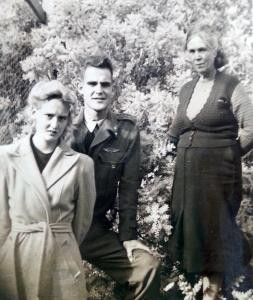
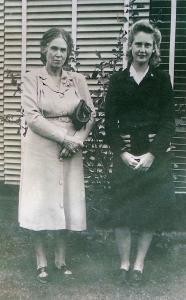
Evacuation to Australia, 1945–1946
After several months in Singapore, Henriette and her mother were evacuated to Australia on a small ‘help cruiser’ arriving in Sydney on 7 April 1946. There is no precise tally of those sent to Australia for ‘recuperative purposes’, but archival documentation and newspaper sources suggest some six thousand evacuees entered the country over eight to ten months.
During the war years, a Netherlands East Indies government-in-exile was established at Camp Columbia in Queensland, and they set up branches of the Netherlands East Indies Welfare Organisation for Evacuees (NIWOE) in each state whose role was to receive and process evacuees, to pay all expenses associated with their ‘recuperation’, and to organise accommodation in private homes, hotels and boarding houses.
Henriette and Mama Grethe flew to Western Australia to be reunited with Kim who had been demobilised as a former member of the joint NEI-RAAF 18thSquadron and sent to Perth, a city he knew well having attended an Agricultural College there in 1940.
A flight from Sydney to Perth took two days in in 1946, where Kim and his wife Yvonne had a room ready for them in the flat they rented in Outram Street, just to the west of the city. An Australian family, the Mawby’s, had taken Kim under their wing following the war and extended their hospitality to Henriette and Grethe:
Every Saturday night, Daphne [Mawby] took me to the tennis club dance, but because of my lack of English and shyness I did not make many friends. … On Sundays we went to Mrs Mawby for high tea. She was very English and kept her traditions. I used to enjoy these visits; it was a really nice family gathering with their four children present. A cosy room with a roaring wood fire and wonderful food (Henriette).
Henriette was now 16 years of age and had not been schooled for over four-and-a-half years. Now she was able to attend a special school for Dutch evacuees that had been set up at Burt Hall adjoining St Georges Cathedral in Perth.
She also has an unidentified 1946 newspaper item that describes the school for Dutch evacuees.
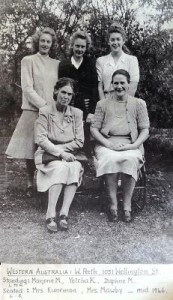
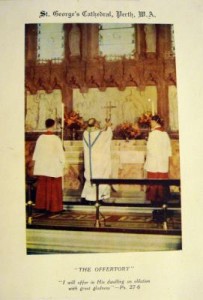
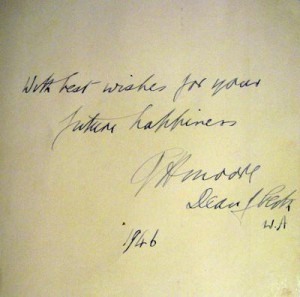

When I asked Henriette what she remembered of the school she said, ‘Nothing, Sue. I remember nothing. Not a single thing.’ And why? Henriette was catching up for lost time: she laughed a lot, was playful, spirited, effervescent, went to the movies, rode horses, played tennis, swam in the pool at Nedlands on the Swan River (now Jo Jos restaurant), and was having the time of her life. When I mentioned the money given to evacuees by the Dutch authorities she said, ‘Oh, so that’s why I always had £2 in my pocket’. In retrospect, she described this interval between three-and-a-half years spent in a POW camp and her repatriation to the Netherlands as an ‘age of innocence’ and as ‘the best time in my life’. (See The Dutch in Western Australia: 1616 – 2016, Western Australian Museum Press, 2014.)
Repatriation to Holland in 1946 and return to Australia in 1953
Grethe Kuneman’s intention was to remain in Australia as self-funded migrants as her husband Jan had invested considerable money in British and American banks prior to war.
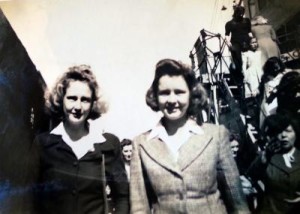
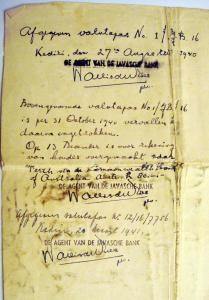
The Mawby family was also willing to sponsor them. But just after Henriette was enrolled at St Hilda’s Girls College, Grethe changed her mind and booked a passage for Henriette and herself to return to Holland on HMAS Volendam on 2 September 1946. It was a late booking, and a very difficult journey as the only accommodation left was in the bowels of the ship.
They arrived in Rotterdam on a cold, wet and windy day in early October 1946. The hostile welcome given to the Dutch from the Netherlands East Indies is well documented. Holland was a country immersed in its own problems and not interested in the wartime experiences of the ‘Other’ Dutch who were all too often portrayed as ‘spoilt colonialists’— despite the efforts of the Dutch government to retain its former colony. For a child brought up in the colour and vibrancy of Java, post-war Holland presented as a cold, dark, gloomy, sombre and unwelcoming country and from the moment she arrived Henriette was determined to leave.
She brought to Holland her bright orange Malvern Star bicycle that she had purchased in Perth, Western Australia. The Dutch were horrified as it looked looked out of place in the grey-black colour scheme of post-war Europe. At one point, someone took one look at the bike and called her a harlot—despite the fact that orange is Holland’s national colour.
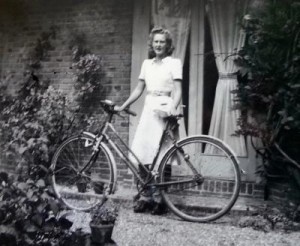
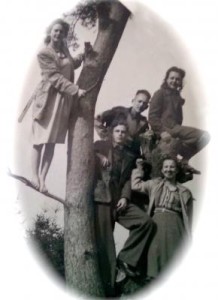

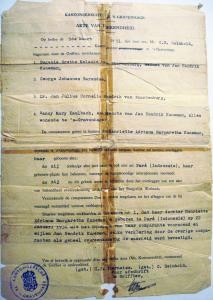
It took seven years for Henriette to return to Australia and much had changed in her life. She boarded the Johan van Oldebarneveldt on 6 October 1953 with her husband Mark and her two children, Mark and Paul, born in 1951 and 1953 respectively.
Henriette worked hard as a waitress, counterhand and later as a nurse to establish herself, and the family, in Perth, Western Australia. So was delighted to return to a colourful country with reasonable weather. Yet this is another era in her life, another story to tell. It has had its ups and downs but through it all is a determined woman, one who has the capacity to engage with others, to draw interesting and helpful people into her life. She was naturalised in 1961 and now lives some 50 kilometres north of Perth in a house that is different to, yet evocative of, her early years in the Netherlands East Indies. The hibiscus and other colourful plants in the garden, the photos and memorabilia within the home. This is Henriette: colourful, articulate, out of the ordinary, a pleasure to meet.
Additional images for researcher information
Above: 20 December 1948 issue of A.I.D. Morning Bulletin, a Dutch paper reporting on events in Java
- Written and researched by: Dr Sue Summers (2014) based on April 2006, October 2008, August 2013, and February–June 2014 interviews with Henriette Thomas (nee Kuneman); questionnaires; and Henriette’s unpublished autobiography, From revolution to chaos: The reminiscences of the horizontal aunt (n.d.) ©
- Funded by: Your Community Heritage Grants by The Department of the Environment, Canberra.
- Interview Series 2014: organised by Dr Nonja Peters, History of Migration Experiences (HOME), Curtin University, Perth Western Australia.
















